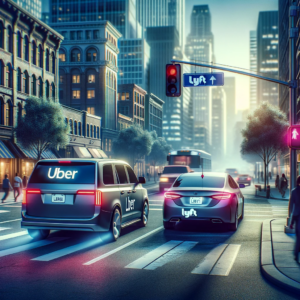Uber and Lyft Ride Safety
January 22, 2024 | Written by Jerry Nicklow
Uber and Lyft Ride Safety: Navigating the Risks of Unofficial Rides
 In an age where Uber and Lyft have become synonymous with convenient travel, it’s important to understand the safety implications of using these services unofficially. While it might seem convenient to call an Uber or Lyft driver directly and skip the app, this practice poses significant safety and insurance risks. In this post, we’ll delve into why using the official Uber and Lyft apps is essential for your safety, particularly from an insurance perspective. Read on for more Uber and Lyft ride safety tips.
In an age where Uber and Lyft have become synonymous with convenient travel, it’s important to understand the safety implications of using these services unofficially. While it might seem convenient to call an Uber or Lyft driver directly and skip the app, this practice poses significant safety and insurance risks. In this post, we’ll delve into why using the official Uber and Lyft apps is essential for your safety, particularly from an insurance perspective. Read on for more Uber and Lyft ride safety tips.
Nancy and I were recently at an insurance convention in Puerto Rico. While taking an official Uber trip back from a local restaurant, our driver’s phone rang for an unofficial ride request. The part that was surprising to me was that the caller was another attendee at the conference, and an insurance agent.
My mind was a bit blown because if anyone should understand the insurance implications of taking an unofficial Uber ride, it should be the insurance agent on the other end of the phone call. Saving a few dollars on a ride is not worth risking your financial future for should there be an accident.
The Importance of Official Booking on Uber and Lyft
Both Uber and Lyft have clear guidelines that all rides should be booked through their respective apps. This is a cornerstone of their safety protocols, ensuring both driver and rider protection.
Key Safety Features in the Uber and Lyft Apps
- Driver Verification: The apps ensure that the person driving is the same individual who passed background checks.
- Real-Time Trip Tracking: Enables your journey to be tracked, enhancing safety.
- Transparent and Pre-Agreed Pricing: Avoids fare disputes and overcharging.
Insurance Coverage: Uber and Lyft’s Official Rides vs. Unofficial Rides
One of the most critical aspects where official and unofficial rides differ is insurance coverage.
Uber and Lyft’s Insurance for Official Rides
- Liability Insurance Coverage: Covers injuries and property damage to third parties in an accident caused by the Uber or Lyft driver.
- Uninsured/Underinsured Motorist Coverage: Protects passengers if an accident is caused by a driver lacking adequate insurance.
- Insurance Coverage Phases For Uber Aand Lyft Rides: Insurance varies based on whether the driver is waiting for a ride request, en route to pick up a passenger, or during trips.
The Insurance Gap in Unofficial Rides
- Lack of Platform-Specific Coverage: Uber and Lyft’s commercial auto liability insurance and uninsured motorist coverage do not apply to unofficial rides.
- Personal Insurance May Not Suffice: Many personal car insurance policies do not cover commercial use, which can leave both drivers and passengers at risk in the event of an accident.
Why Unofficial Rides Are Risky
Taking a ride outside the official Uber or Lyft apps introduces several risks:
Compromised Safety Measures
Without the app’s safety features, you essentially lose the assurance of verified drivers and secure trip tracking.
Legal and Financial Implications
- Drivers Risk Policy Violation: They might be violating terms of service with Uber and Lyft, risking deactivation.
- Insurance Fraud Risks: Claims made for incidents during unofficial rides may be considered fraudulent, as most personal insurances exclude commercial activities. Many personal auto insurance policies do offer an endorsement to allow for Uber and Lyft driving. But they rely on Uber and Lyft providing the primary coverage during rides. So, there still may be a huge gap in insurance for taking these “unofficial” ride sharing rides.
What Passengers Should Do
- Always Book Through the App: To ensure safety and insurance coverage.
- Check the Driver and Vehicle: Confirm that they match the app’s details. Verify the tag number and wait for the driver to call you by name before entering the vehicle.
- Share Trip Details: With trusted contacts for added safety. When I am on the road, I share my Uber trip details with my wife or my kids if they are not traveling with me.
Staying Safe with Uber and Lyft
Prioritizing safety with Uber and Lyft means more than just booking through the app. Here are additional tips to enhance your safety:
- Wait Safely for Your Ride: Choose a secure location to wait for your driver.
- Verify the Car and Driver: Double-check the car model, color, and license plate, as well as the driver’s appearance and name against the app’s information.
- Share Your Trip Details: Use the in-app feature to share your trip details with family or friends.
- Be Aware of Your Surroundings: Always be alert to your environment when entering or exiting the vehicle.
Conclusion
In the realm of ridesharing with Uber and Lyft, your safety and insurance protection are paramount. Unofficial rides, although they might seem convenient at first glance, expose you to unnecessary risks and potential legal and insurance complications. By sticking to the official process and being aware of your surroundings, you ensure a safer and more secure travel experience.
At Huff Insurance, we are dedicated to your safety and well-being. For more insights and tips on safe travel and insurance knowledge, keep up with our blog.
Remember, when it comes to ridesharing, an ounce of prevention is worth a pound of cure. Stay safe, stay insured, and travel smart!
